Analysis of Conspicuous Consumption: Social and Psychological Impact
VerifiedAdded on 2023/06/07
|7
|1533
|292
Essay
AI Summary
This essay delves into the concept of conspicuous consumption, defining it as the purchase of goods and services to display wealth and social status. It explores the factors influencing buying behavior, including marketing, social, psychological, cultural, and personal elements. The essay discusses the effects of consumption, such as the Veblen effect, which links the purchase of luxury goods to social standing. It also examines limitations like the effects of joining the majority and the snob effect, which influence consumer choices. References are provided to support the analysis of conspicuous consumption and its impact on society and marketing strategies.
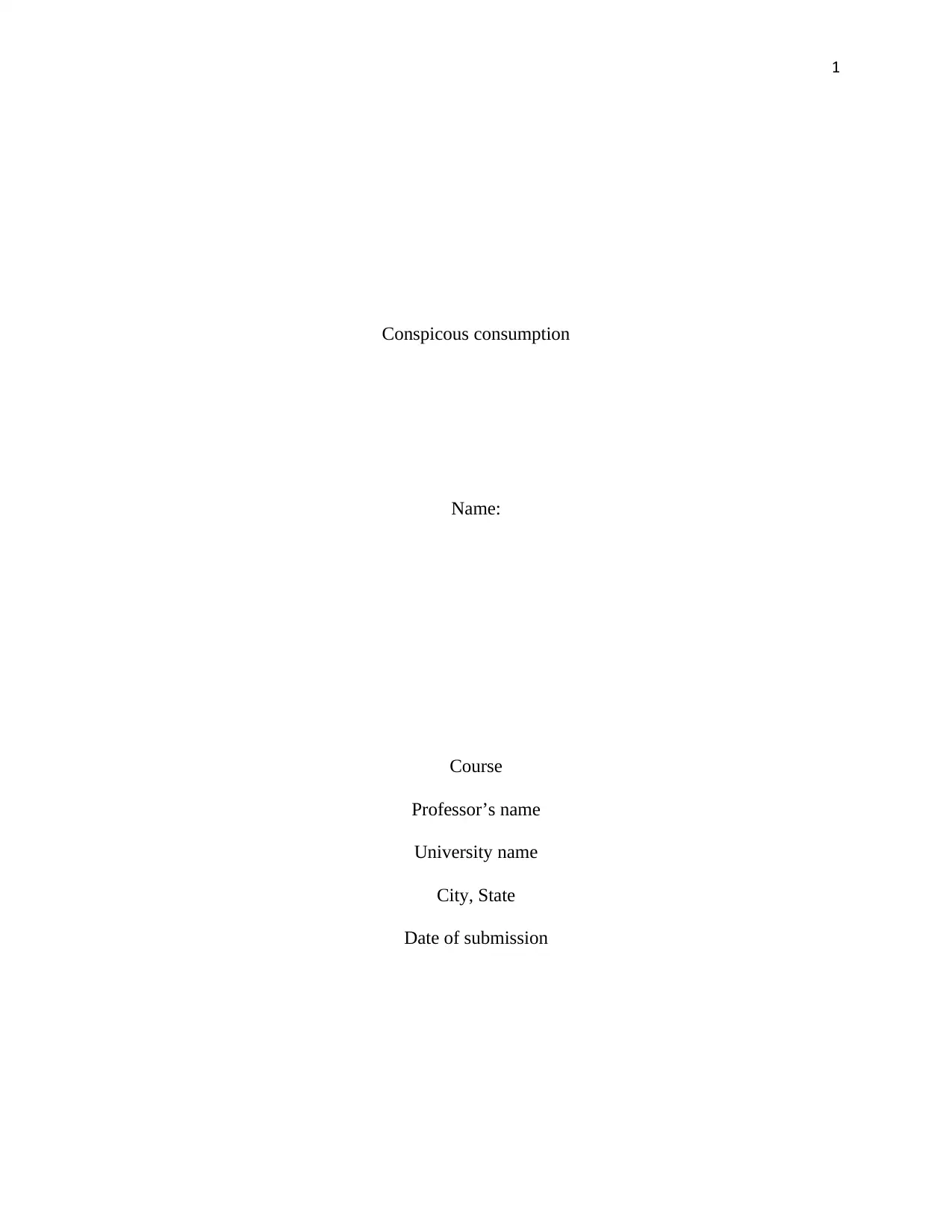
1
Conspicous consumption
Name:
Course
Professor’s name
University name
City, State
Date of submission
Conspicous consumption
Name:
Course
Professor’s name
University name
City, State
Date of submission
Paraphrase This Document
Need a fresh take? Get an instant paraphrase of this document with our AI Paraphraser
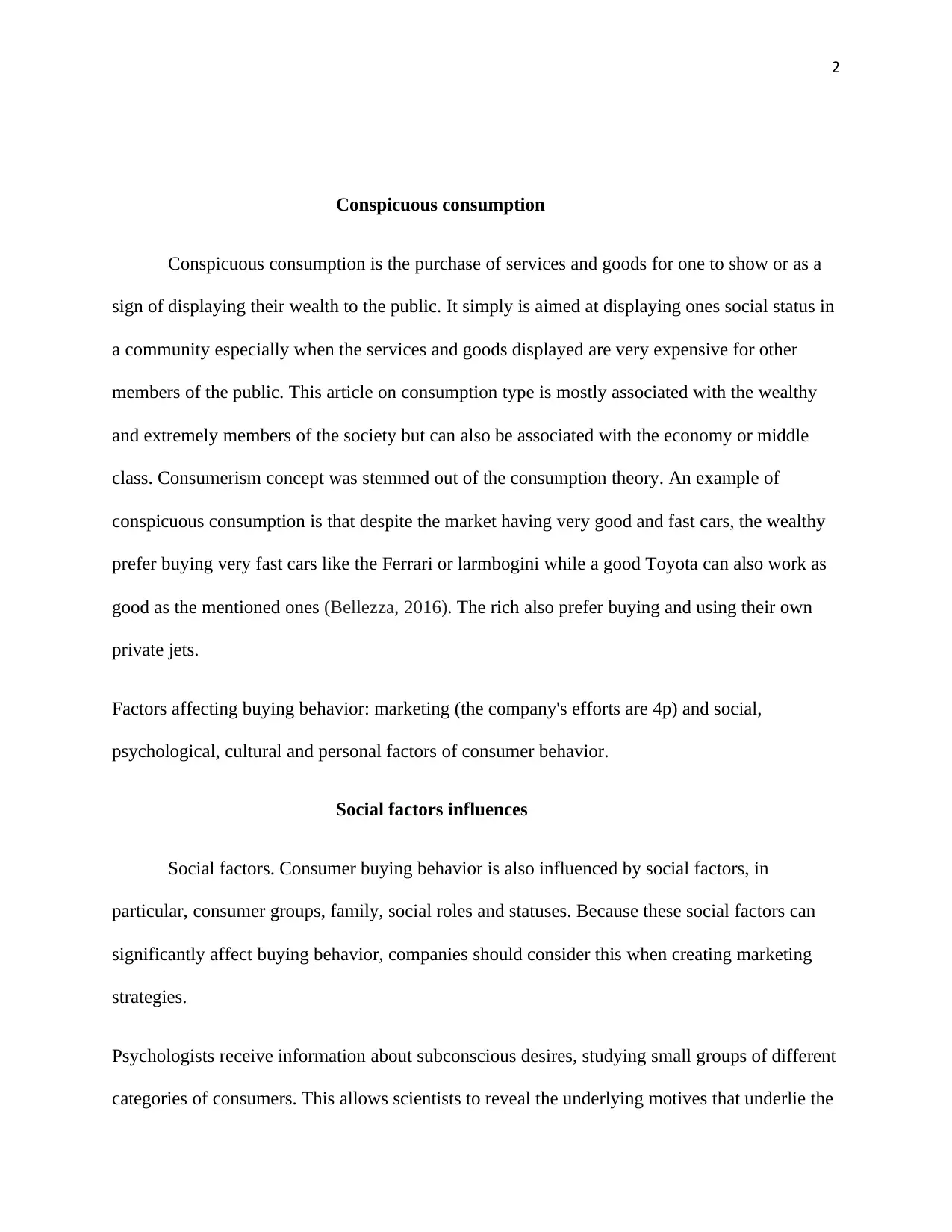
2
Conspicuous consumption
Conspicuous consumption is the purchase of services and goods for one to show or as a
sign of displaying their wealth to the public. It simply is aimed at displaying ones social status in
a community especially when the services and goods displayed are very expensive for other
members of the public. This article on consumption type is mostly associated with the wealthy
and extremely members of the society but can also be associated with the economy or middle
class. Consumerism concept was stemmed out of the consumption theory. An example of
conspicuous consumption is that despite the market having very good and fast cars, the wealthy
prefer buying very fast cars like the Ferrari or larmbogini while a good Toyota can also work as
good as the mentioned ones (Bellezza, 2016). The rich also prefer buying and using their own
private jets.
Factors affecting buying behavior: marketing (the company's efforts are 4p) and social,
psychological, cultural and personal factors of consumer behavior.
Social factors influences
Social factors. Consumer buying behavior is also influenced by social factors, in
particular, consumer groups, family, social roles and statuses. Because these social factors can
significantly affect buying behavior, companies should consider this when creating marketing
strategies.
Psychologists receive information about subconscious desires, studying small groups of different
categories of consumers. This allows scientists to reveal the underlying motives that underlie the
Conspicuous consumption
Conspicuous consumption is the purchase of services and goods for one to show or as a
sign of displaying their wealth to the public. It simply is aimed at displaying ones social status in
a community especially when the services and goods displayed are very expensive for other
members of the public. This article on consumption type is mostly associated with the wealthy
and extremely members of the society but can also be associated with the economy or middle
class. Consumerism concept was stemmed out of the consumption theory. An example of
conspicuous consumption is that despite the market having very good and fast cars, the wealthy
prefer buying very fast cars like the Ferrari or larmbogini while a good Toyota can also work as
good as the mentioned ones (Bellezza, 2016). The rich also prefer buying and using their own
private jets.
Factors affecting buying behavior: marketing (the company's efforts are 4p) and social,
psychological, cultural and personal factors of consumer behavior.
Social factors influences
Social factors. Consumer buying behavior is also influenced by social factors, in
particular, consumer groups, family, social roles and statuses. Because these social factors can
significantly affect buying behavior, companies should consider this when creating marketing
strategies.
Psychologists receive information about subconscious desires, studying small groups of different
categories of consumers. This allows scientists to reveal the underlying motives that underlie the
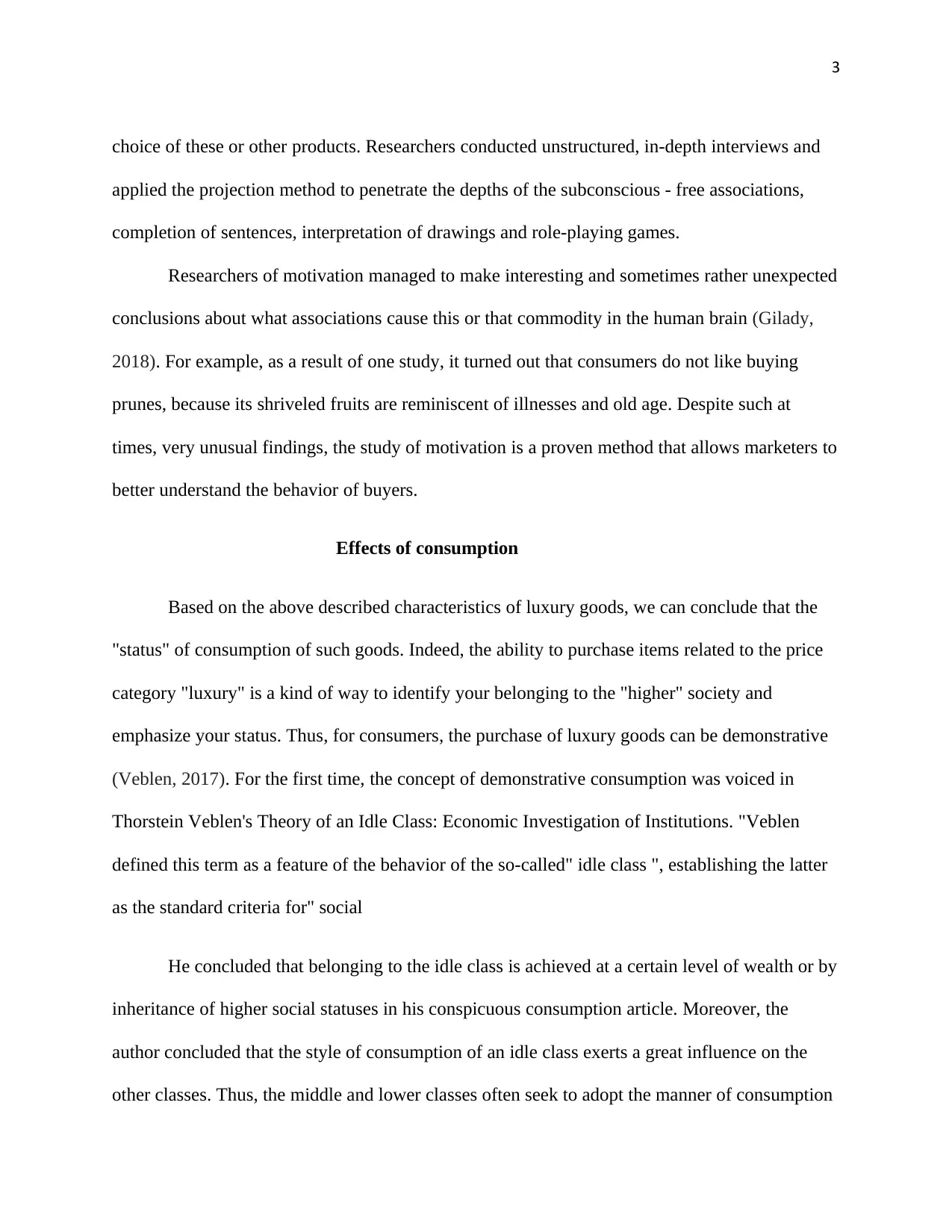
3
choice of these or other products. Researchers conducted unstructured, in-depth interviews and
applied the projection method to penetrate the depths of the subconscious - free associations,
completion of sentences, interpretation of drawings and role-playing games.
Researchers of motivation managed to make interesting and sometimes rather unexpected
conclusions about what associations cause this or that commodity in the human brain (Gilady,
2018). For example, as a result of one study, it turned out that consumers do not like buying
prunes, because its shriveled fruits are reminiscent of illnesses and old age. Despite such at
times, very unusual findings, the study of motivation is a proven method that allows marketers to
better understand the behavior of buyers.
Effects of consumption
Based on the above described characteristics of luxury goods, we can conclude that the
"status" of consumption of such goods. Indeed, the ability to purchase items related to the price
category "luxury" is a kind of way to identify your belonging to the "higher" society and
emphasize your status. Thus, for consumers, the purchase of luxury goods can be demonstrative
(Veblen, 2017). For the first time, the concept of demonstrative consumption was voiced in
Thorstein Veblen's Theory of an Idle Class: Economic Investigation of Institutions. "Veblen
defined this term as a feature of the behavior of the so-called" idle class ", establishing the latter
as the standard criteria for" social
He concluded that belonging to the idle class is achieved at a certain level of wealth or by
inheritance of higher social statuses in his conspicuous consumption article. Moreover, the
author concluded that the style of consumption of an idle class exerts a great influence on the
other classes. Thus, the middle and lower classes often seek to adopt the manner of consumption
choice of these or other products. Researchers conducted unstructured, in-depth interviews and
applied the projection method to penetrate the depths of the subconscious - free associations,
completion of sentences, interpretation of drawings and role-playing games.
Researchers of motivation managed to make interesting and sometimes rather unexpected
conclusions about what associations cause this or that commodity in the human brain (Gilady,
2018). For example, as a result of one study, it turned out that consumers do not like buying
prunes, because its shriveled fruits are reminiscent of illnesses and old age. Despite such at
times, very unusual findings, the study of motivation is a proven method that allows marketers to
better understand the behavior of buyers.
Effects of consumption
Based on the above described characteristics of luxury goods, we can conclude that the
"status" of consumption of such goods. Indeed, the ability to purchase items related to the price
category "luxury" is a kind of way to identify your belonging to the "higher" society and
emphasize your status. Thus, for consumers, the purchase of luxury goods can be demonstrative
(Veblen, 2017). For the first time, the concept of demonstrative consumption was voiced in
Thorstein Veblen's Theory of an Idle Class: Economic Investigation of Institutions. "Veblen
defined this term as a feature of the behavior of the so-called" idle class ", establishing the latter
as the standard criteria for" social
He concluded that belonging to the idle class is achieved at a certain level of wealth or by
inheritance of higher social statuses in his conspicuous consumption article. Moreover, the
author concluded that the style of consumption of an idle class exerts a great influence on the
other classes. Thus, the middle and lower classes often seek to adopt the manner of consumption
⊘ This is a preview!⊘
Do you want full access?
Subscribe today to unlock all pages.

Trusted by 1+ million students worldwide
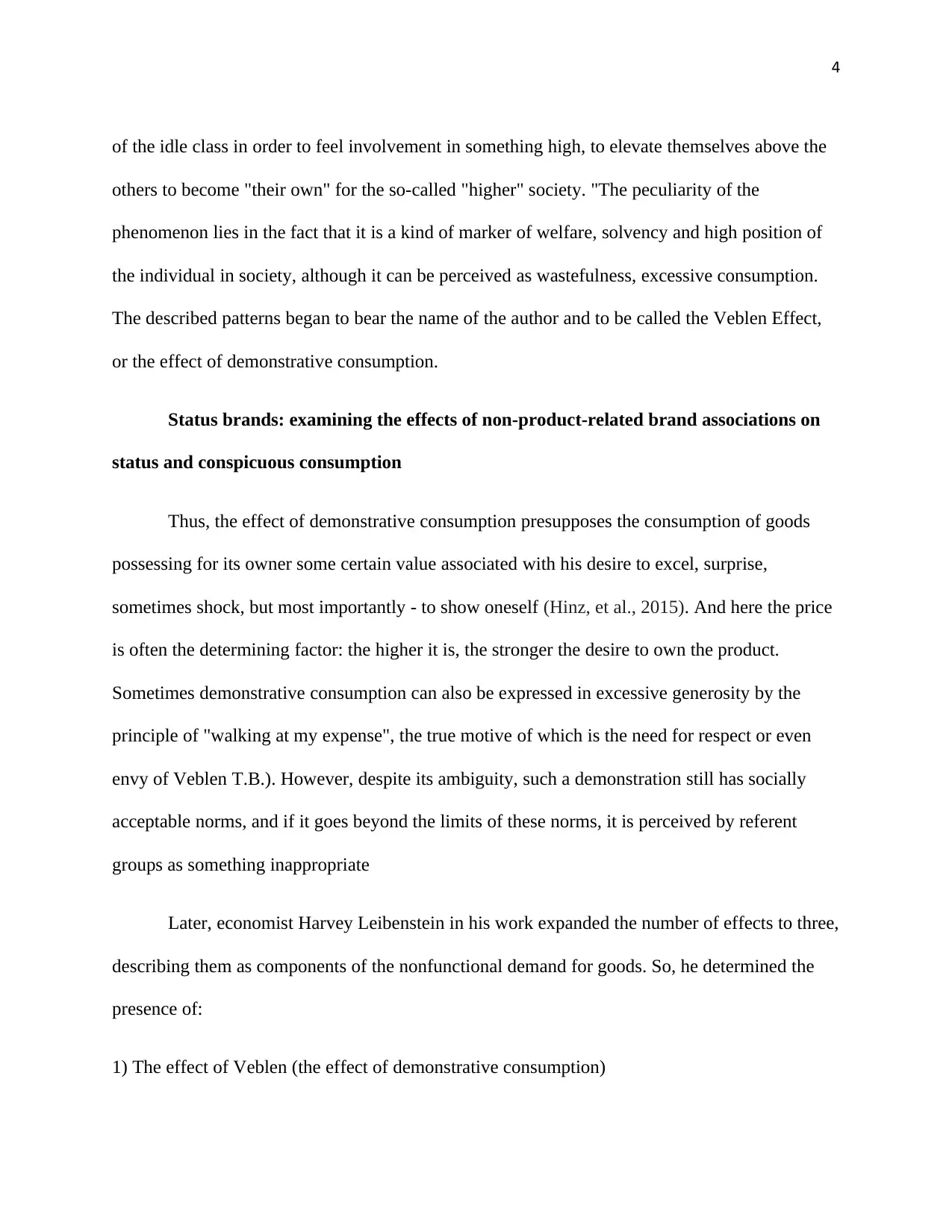
4
of the idle class in order to feel involvement in something high, to elevate themselves above the
others to become "their own" for the so-called "higher" society. "The peculiarity of the
phenomenon lies in the fact that it is a kind of marker of welfare, solvency and high position of
the individual in society, although it can be perceived as wastefulness, excessive consumption.
The described patterns began to bear the name of the author and to be called the Veblen Effect,
or the effect of demonstrative consumption.
Status brands: examining the effects of non-product-related brand associations on
status and conspicuous consumption
Thus, the effect of demonstrative consumption presupposes the consumption of goods
possessing for its owner some certain value associated with his desire to excel, surprise,
sometimes shock, but most importantly - to show oneself (Hinz, et al., 2015). And here the price
is often the determining factor: the higher it is, the stronger the desire to own the product.
Sometimes demonstrative consumption can also be expressed in excessive generosity by the
principle of "walking at my expense", the true motive of which is the need for respect or even
envy of Veblen T.B.). However, despite its ambiguity, such a demonstration still has socially
acceptable norms, and if it goes beyond the limits of these norms, it is perceived by referent
groups as something inappropriate
Later, economist Harvey Leibenstein in his work expanded the number of effects to three,
describing them as components of the nonfunctional demand for goods. So, he determined the
presence of:
1) The effect of Veblen (the effect of demonstrative consumption)
of the idle class in order to feel involvement in something high, to elevate themselves above the
others to become "their own" for the so-called "higher" society. "The peculiarity of the
phenomenon lies in the fact that it is a kind of marker of welfare, solvency and high position of
the individual in society, although it can be perceived as wastefulness, excessive consumption.
The described patterns began to bear the name of the author and to be called the Veblen Effect,
or the effect of demonstrative consumption.
Status brands: examining the effects of non-product-related brand associations on
status and conspicuous consumption
Thus, the effect of demonstrative consumption presupposes the consumption of goods
possessing for its owner some certain value associated with his desire to excel, surprise,
sometimes shock, but most importantly - to show oneself (Hinz, et al., 2015). And here the price
is often the determining factor: the higher it is, the stronger the desire to own the product.
Sometimes demonstrative consumption can also be expressed in excessive generosity by the
principle of "walking at my expense", the true motive of which is the need for respect or even
envy of Veblen T.B.). However, despite its ambiguity, such a demonstration still has socially
acceptable norms, and if it goes beyond the limits of these norms, it is perceived by referent
groups as something inappropriate
Later, economist Harvey Leibenstein in his work expanded the number of effects to three,
describing them as components of the nonfunctional demand for goods. So, he determined the
presence of:
1) The effect of Veblen (the effect of demonstrative consumption)
Paraphrase This Document
Need a fresh take? Get an instant paraphrase of this document with our AI Paraphraser
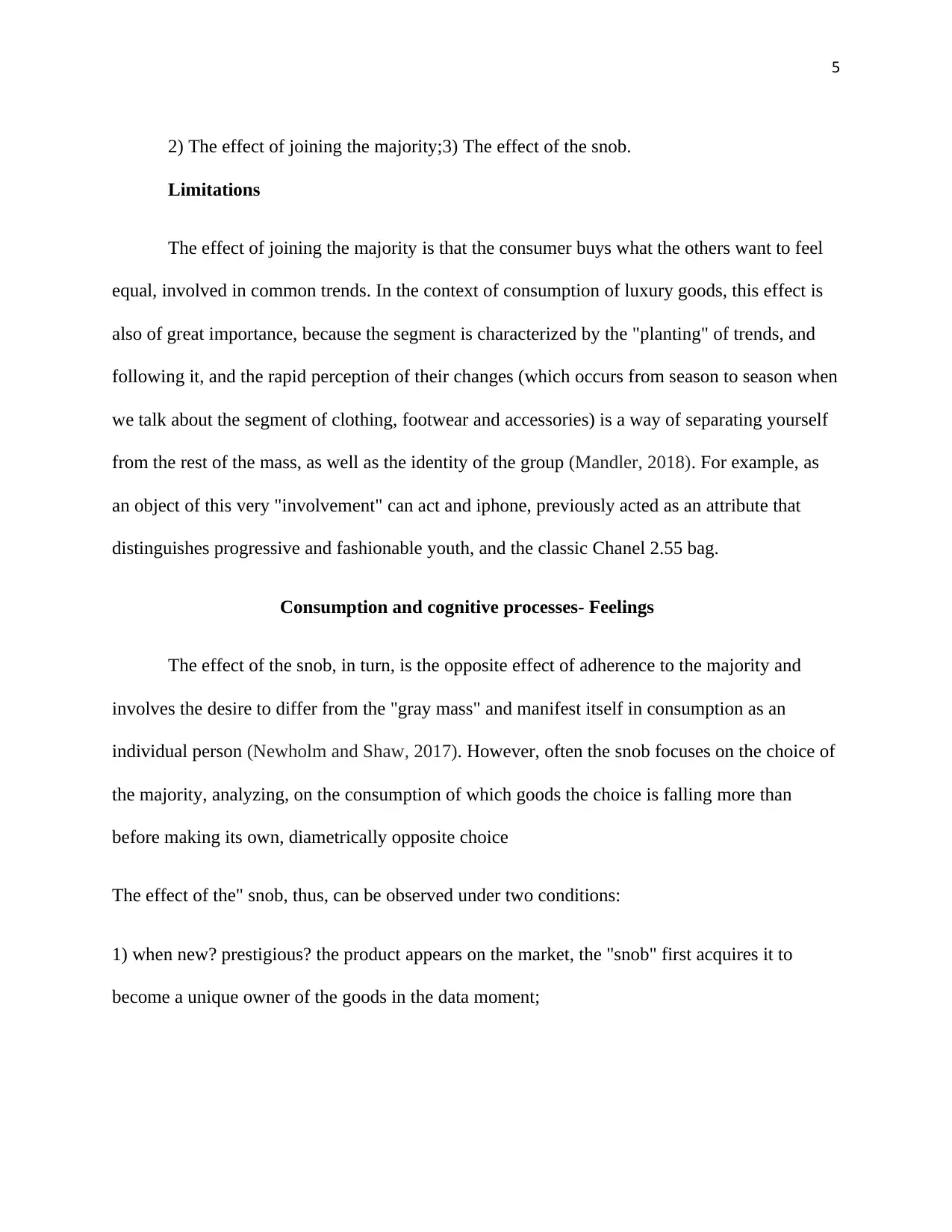
5
2) The effect of joining the majority;3) The effect of the snob.
Limitations
The effect of joining the majority is that the consumer buys what the others want to feel
equal, involved in common trends. In the context of consumption of luxury goods, this effect is
also of great importance, because the segment is characterized by the "planting" of trends, and
following it, and the rapid perception of their changes (which occurs from season to season when
we talk about the segment of clothing, footwear and accessories) is a way of separating yourself
from the rest of the mass, as well as the identity of the group (Mandler, 2018). For example, as
an object of this very "involvement" can act and iphone, previously acted as an attribute that
distinguishes progressive and fashionable youth, and the classic Chanel 2.55 bag.
Consumption and cognitive processes- Feelings
The effect of the snob, in turn, is the opposite effect of adherence to the majority and
involves the desire to differ from the "gray mass" and manifest itself in consumption as an
individual person (Newholm and Shaw, 2017). However, often the snob focuses on the choice of
the majority, analyzing, on the consumption of which goods the choice is falling more than
before making its own, diametrically opposite choice
The effect of the" snob, thus, can be observed under two conditions:
1) when new? prestigious? the product appears on the market, the "snob" first acquires it to
become a unique owner of the goods in the data moment;
2) The effect of joining the majority;3) The effect of the snob.
Limitations
The effect of joining the majority is that the consumer buys what the others want to feel
equal, involved in common trends. In the context of consumption of luxury goods, this effect is
also of great importance, because the segment is characterized by the "planting" of trends, and
following it, and the rapid perception of their changes (which occurs from season to season when
we talk about the segment of clothing, footwear and accessories) is a way of separating yourself
from the rest of the mass, as well as the identity of the group (Mandler, 2018). For example, as
an object of this very "involvement" can act and iphone, previously acted as an attribute that
distinguishes progressive and fashionable youth, and the classic Chanel 2.55 bag.
Consumption and cognitive processes- Feelings
The effect of the snob, in turn, is the opposite effect of adherence to the majority and
involves the desire to differ from the "gray mass" and manifest itself in consumption as an
individual person (Newholm and Shaw, 2017). However, often the snob focuses on the choice of
the majority, analyzing, on the consumption of which goods the choice is falling more than
before making its own, diametrically opposite choice
The effect of the" snob, thus, can be observed under two conditions:
1) when new? prestigious? the product appears on the market, the "snob" first acquires it to
become a unique owner of the goods in the data moment;
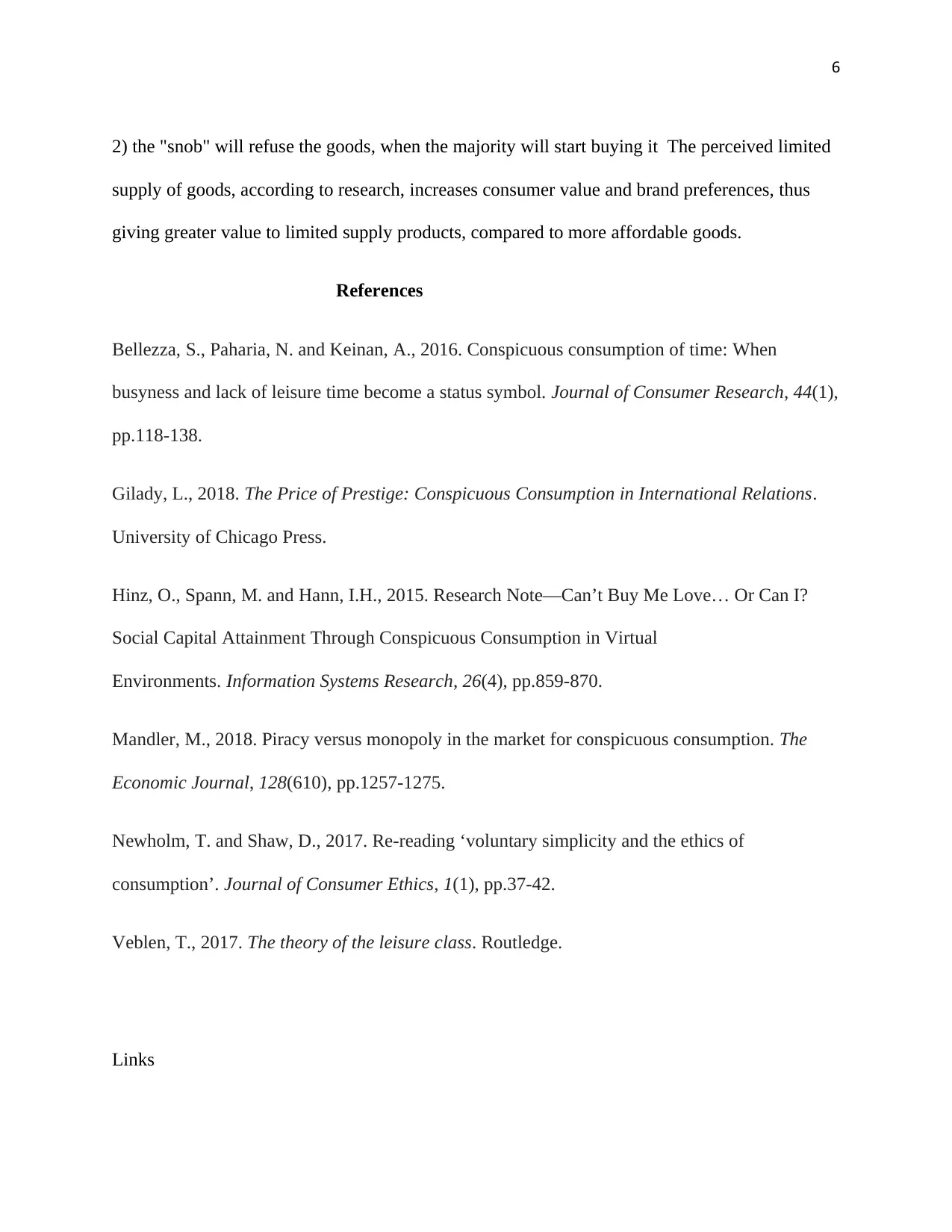
6
2) the "snob" will refuse the goods, when the majority will start buying it The perceived limited
supply of goods, according to research, increases consumer value and brand preferences, thus
giving greater value to limited supply products, compared to more affordable goods.
References
Bellezza, S., Paharia, N. and Keinan, A., 2016. Conspicuous consumption of time: When
busyness and lack of leisure time become a status symbol. Journal of Consumer Research, 44(1),
pp.118-138.
Gilady, L., 2018. The Price of Prestige: Conspicuous Consumption in International Relations.
University of Chicago Press.
Hinz, O., Spann, M. and Hann, I.H., 2015. Research Note—Can’t Buy Me Love… Or Can I?
Social Capital Attainment Through Conspicuous Consumption in Virtual
Environments. Information Systems Research, 26(4), pp.859-870.
Mandler, M., 2018. Piracy versus monopoly in the market for conspicuous consumption. The
Economic Journal, 128(610), pp.1257-1275.
Newholm, T. and Shaw, D., 2017. Re-reading ‘voluntary simplicity and the ethics of
consumption’. Journal of Consumer Ethics, 1(1), pp.37-42.
Veblen, T., 2017. The theory of the leisure class. Routledge.
Links
2) the "snob" will refuse the goods, when the majority will start buying it The perceived limited
supply of goods, according to research, increases consumer value and brand preferences, thus
giving greater value to limited supply products, compared to more affordable goods.
References
Bellezza, S., Paharia, N. and Keinan, A., 2016. Conspicuous consumption of time: When
busyness and lack of leisure time become a status symbol. Journal of Consumer Research, 44(1),
pp.118-138.
Gilady, L., 2018. The Price of Prestige: Conspicuous Consumption in International Relations.
University of Chicago Press.
Hinz, O., Spann, M. and Hann, I.H., 2015. Research Note—Can’t Buy Me Love… Or Can I?
Social Capital Attainment Through Conspicuous Consumption in Virtual
Environments. Information Systems Research, 26(4), pp.859-870.
Mandler, M., 2018. Piracy versus monopoly in the market for conspicuous consumption. The
Economic Journal, 128(610), pp.1257-1275.
Newholm, T. and Shaw, D., 2017. Re-reading ‘voluntary simplicity and the ethics of
consumption’. Journal of Consumer Ethics, 1(1), pp.37-42.
Veblen, T., 2017. The theory of the leisure class. Routledge.
Links
⊘ This is a preview!⊘
Do you want full access?
Subscribe today to unlock all pages.

Trusted by 1+ million students worldwide

7
https://scholar.google.com/scholar?
as_ylo=2014&q=conspicuous+consumption&hl=en&as_sdt=0,5#d=gs_cit&p=&u=%2Fscholar
%3Fq%3Dinfo%3A6aFDD7zFmGkJ%3Aschol
https://scholar.google.com/scholar?
as_ylo=2014&q=conspicuous+consumption&hl=en&as_sdt=0,5
https://scholar.google.com/scholar?as_ylo=2014&q=conspicuous+consumption&hl=
https://scholar.google.com/scholar?
hl=en&as_sdt=0,5&qsp=3&q=conspicuous+consumption+luxury
https://scholar.google.com/scholar?cluster=13704357387455792468&hl=en&as_sdt=0,5
https://scholar.google.com/scholar?
as_ylo=2014&q=conspicuous+consumption&hl=en&as_sdt=0,5#d=gs_cit&p=&u=%2Fscholar
%3Fq%3Dinfo%3A6aFDD7zFmGkJ%3Aschol
https://scholar.google.com/scholar?
as_ylo=2014&q=conspicuous+consumption&hl=en&as_sdt=0,5
https://scholar.google.com/scholar?as_ylo=2014&q=conspicuous+consumption&hl=
https://scholar.google.com/scholar?
hl=en&as_sdt=0,5&qsp=3&q=conspicuous+consumption+luxury
https://scholar.google.com/scholar?cluster=13704357387455792468&hl=en&as_sdt=0,5
1 out of 7
Related Documents
Your All-in-One AI-Powered Toolkit for Academic Success.
+13062052269
info@desklib.com
Available 24*7 on WhatsApp / Email
![[object Object]](/_next/static/media/star-bottom.7253800d.svg)
Unlock your academic potential
Copyright © 2020–2025 A2Z Services. All Rights Reserved. Developed and managed by ZUCOL.




